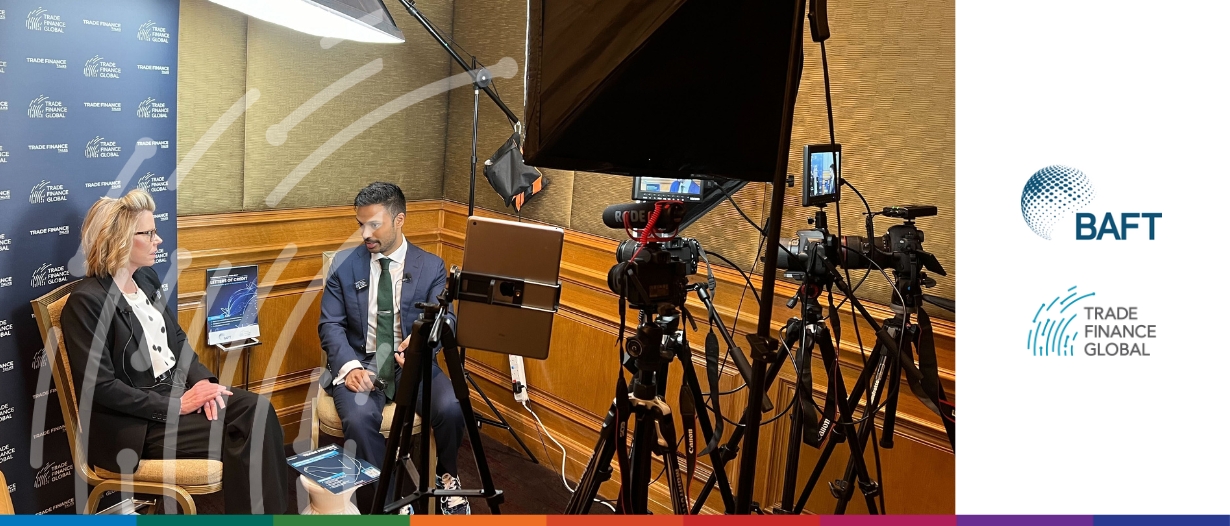Estimated reading time: 5 minutes
In 2024, we want everything to be instant. From our food delivery services to our ride-share apps, we expect speed and efficiency. The underlying aspect of all of these services is the payments industry.
But there is an entire infrastructure that needs to be developed and maintained to create the instantaneous payments that we all want.
At the BAFT 2024 International Trade and Payments Conference in Washington, D.C., TFG’s Deepesh Patel was joined by Karrie Rodriquez, Assistant Vice President at the Federal Reserve Bank of Boston, to explore the evolving landscape of the payments industry and discuss key macroeconomic and monetary policy updates, the FedNow Service, and faster payments.
The FedNow Service: What is it?
The FedNow Service is an instant payment service launched by the Fed in July 2023. Instant payment services allow consumers and businesses to send and receive funds in real-time throughout the day and year, accompanied by immediate availability of the funds to the receiver.
Any financial institution is able to sign up and offer instant payment services to their customers. Rodriquez said, “There’s a wide range of benefits with instant payments, especially during emergency situations and for families living paycheck-to-paycheck.”
To date, 607 financial institutions, across 46 states, participate in the FedNow Service, making it a readily available option for customers across the United States.
The role of industry collaboration in the FedNow Service
Industry collaboration in an initiative such as the FedNow Service was key, particularly the role of feedback from industry actors in the development of and ongoing enhancements to the service.
The Federal Reserve had chosen to develop the FedNow Service in part based on strong industry demand for greater choice and availability of instant payments. Rodriquez said, “Early on, we formed the FedNow Service Pilot Program with about 120 financial institutions and organisations that provided early feedback to the development and design of the FedNow Service.”
These organisations also participated in early testing activities to help figure out the best path to move forward. Moreover, several of these organisations have become early adopters of the FedNow Service, and many are strong supporters of instant payment services.
Ongoing collaboration and engagement are essential to ensure the Fed optimally designs features and functionality of the service to continue meeting industry demands.
Rodriquez said, “We do have the Ecosystem Accelerator Subgroup that has payment processors and core banking service providers across the instant payment ecosystem or instant payments in general. They provide input to the design and release priorities of the FedNow Service.”
These organisations also help the needs and interests of solution developers and solution providers. Retaining this ongoing engagement with the industry assists with the formulation of modern, innovative instant payment services across the broader payments industry.
Payments in an era of global volatility
Recent global macroeconomic volatility over the past 24 months has made the payments industry an even more vital player for stability and recovery. The FedNow Service has an important role to play in this regard, assisting companies to manage their operations and liquidity more efficiently.
Moreover, faster payments, as a concept, are becoming increasingly popular and are naturally a growing market segment.
Rodriquez said, “There are definitely benefits…especially during emergency situations and families living paycheque-to-paycheque. But [also for] consumers and businesses; they can use faster payments to help ensure the timely delivery of services and goods. And they can also use faster payments to help with their own liquidity needs.”
Balancing act: Support monetary policy and payments growth
The influence of the FedNow Service in advancing payments must also be balanced with the Federal Reserve’s key strategic aim of supporting monetary policy. The Federal Reserve performs five key functions to promote the health of the US economy, as well as the stability of its payment system.
One of those functions is conducting monetary policy. Another is fostering payment and settlement safety and efficiency through services provided to financial institutions.
Rodriquez said, “The FedNow Service provides a way to make efficient instant payments, and it will help the broader payment industry to build modern and innovative services.”
The key is to find the optimal way to use these services to allow innovators to come in, disrupt, innovate, and challenge the status quo.
The potential of the FedNow Service to support fraud mitigation
Fraud is another complex issue within financial services, particularly in the payments space, and the FedNow Service had a role to play in supporting fraud mitigation. While financial institutions serve as the first line of defence against fraud, the FedNow Service launched with a set of tools tailored to the aim of helping mitigate risk.
These tools included setting transaction limits at the network and participant level. There is also a “negative” list, with some required reporting to ensure adequate due diligence.
Rodriquez said, “These tools are meant to complement a financial institution’s own fraud management strategies. We [the Federal Reserve] will continue to enhance our fraud tools, and one of the upcoming features will allow financial institutions to establish thresholds to reject payments if they exceed cumulative value or velocity levels.”
Another feature allows correspondent banks to set limits for direct respondents. This feature assists correspondents in managing their overall account with the Federal Reserve, as well as assisting in managing credit exposures to the respondents.
Instant and faster payments will have a clear impact on the broader US financial system and economy. Based on surveys from the Federal Reserve, the majority of consumers and businesses are already using faster payments, and they have indicated that they plan to use them more frequently in the future.
On the back of this, Rodriquez predicts tremendous growth will be seen in this area, complemented by new innovative ways for organisations and companies to offer instant payments.





























